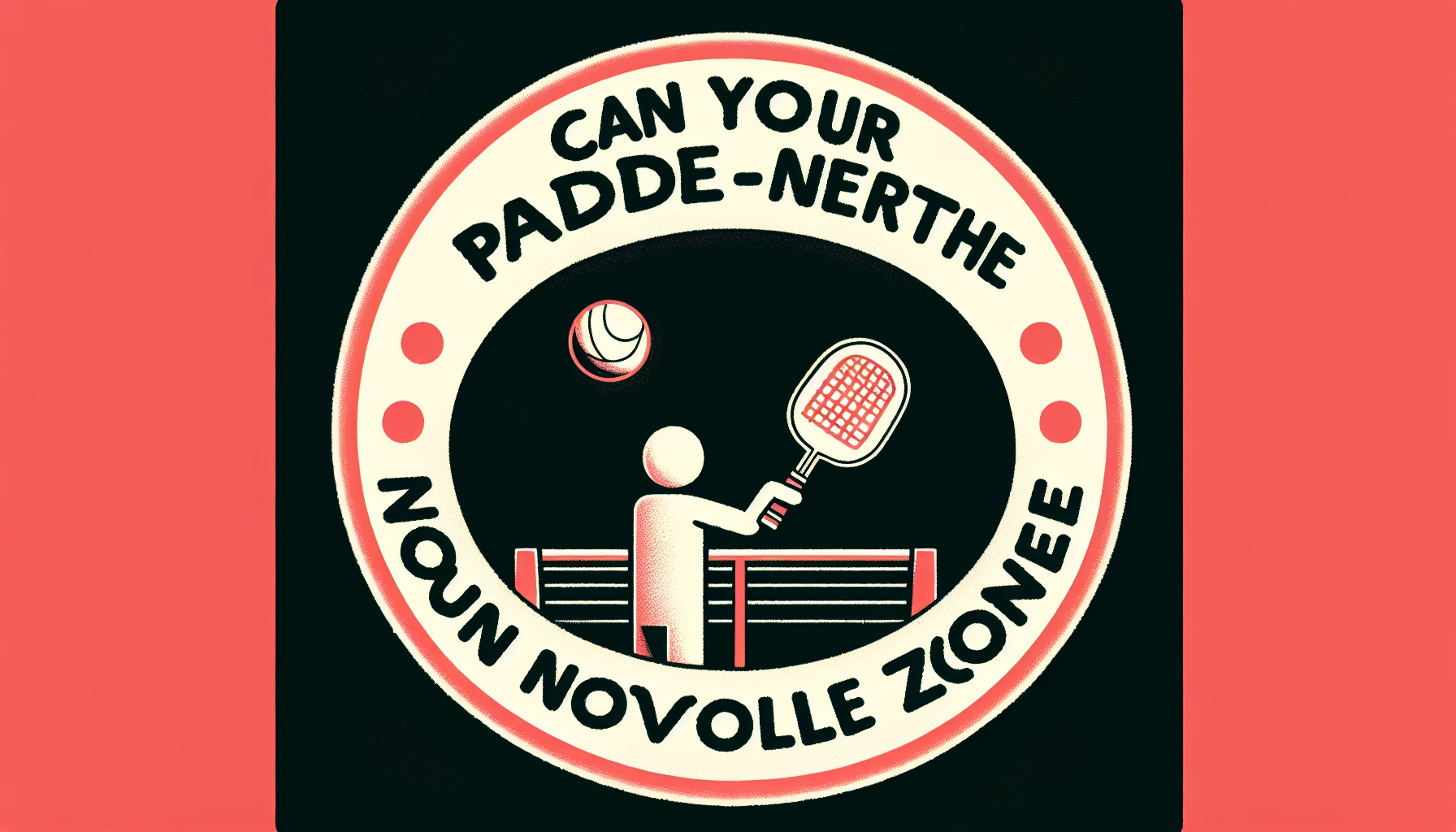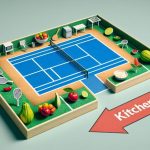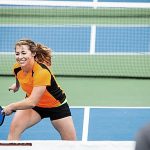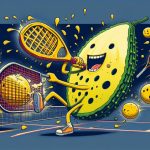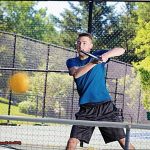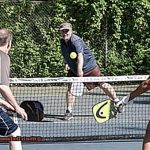Today, we’re tackling a hot topic that has been stirring up quite the debate in the pickleball community: can your paddle enter the non-volley zone? Don’t panic and drop your paddle just yet; let’s approach this topic with an open mind.
As we all know, pickleball is a constantly evolving sport, with new strategies and techniques emerging all the time. So why not consider the possibility of paddles entering the sacred ground of the non-volley zone?
Let’s dive into this controversial question together and weigh its pros and cons with a blend of casualness and professionalism.
Table of Contents
- 1 All Volleys Must Be Initiated Outside the Non-Volley Zone (Rule 9.A)
- 2 Fault if the volleyball player or anything in contact with them touches the non-volley zone (Rule 9.B)
- 3 Fault if the Player’s Momentum Causes Contact with Anything Touching the Non-Volley Zone (Rule 9.C)
- 4 Returning after Contact with the Non-Volley Zone (Rule 9.D)
- 5 Non-Volley Zone Entry Restrictions: Rule 9.E
- 6 Entering the Non-Volley Zone Before or After a Bounced Ball (Rule 9.F)
- 7 Staying in the Non-Volley Zone After Hitting a Bounced Ball: Rule 9.G
- 8 Returning the Ball While the Partner Remains in the Non-Volley Zone (Rule 9.H)
All Volleys Must Be Initiated Outside the Non-Volley Zone (Rule 9.A)
The Mastery of Pickleball: Unraveling the Significance of the Non-Volley Zone Rule
Pickleball, a fast-paced amalgamation of tennis, badminton, and ping-pong, has captured the hearts of players of all ages and skill levels. Like any other sport, it has its own set of regulations that must be adhered to for fair competition.
One such rule, known as “Rule 9.A: All Volleys Must Be Initiated Outside the Non-Volley Zone,” holds great importance in the world of pickleball. As an authority on this rule, I will delve into its purpose and significance for all pickleball enthusiasts.
What is the non-volley zone?
The non-volley zone, also referred to as the kitchen or NVZ, is a 7-foot space on either side of the pickleball court reserved solely for volleying. This implies that players are not allowed to step into this area and strike the ball before it bounces. The rationale behind this rule is to prevent players from standing too close to the net and dominating the game with swift and powerful shots.
Why is the non-volley zone rule crucial?
The non-volley zone rule acts as a barrier between players at the net and those at the baseline. Allowing paddles to enter this zone would give an unfair advantage to those who can execute rapid and forceful shots from close proximity to the net. It also promotes a safer play environment by preventing players from getting too close to each other and potentially causing harm.
Can your paddle enter the non-volley zone?
Some may argue that their paddle accidentally entered the non-volley zone during an intense game, but according to the rules, even unintentional entry is deemed a fault and results in a point for the opposing team. Therefore, players must be mindful of their paddle movements and refrain from any contact with the non-volley zone.
What Happens If You Breach This Rule?
Violating the non-volley zone rule can lead to points for the opposing team, which can ultimately impact the outcome of the game. It is imperative for players to comprehend that not only are they prohibited from stepping into the non-volley zone, but their paddle is also forbidden from entering it. This rule promotes equitable play and ensures that both teams have an equal opportunity to emerge victorious.
Fault if the volleyball player or anything in contact with them touches the non-volley zone (Rule 9.B)
First and foremost, let’s clarify that any interaction with the non-volley zone during the act of volleying is considered a fault. This includes if your wheelchair’s front wheels breach the boundary or if your energy leads you to touch anything in contact with the non-volley zone, such as your partner. This rule applies to all players, regardless of their mobility.
But why is this rule so crucial? The non-volley zone, also known as the kitchen, is a designated area on the court where players are prohibited from entering and hitting the ball. Players getting too close to the net can cause collisions or injuries, which is why this rule exists. It also promotes fair play by providing equal opportunities for both teams to hit the ball without obstruction.
For players using wheelchairs, maneuvering around the non-volley zone can be quite challenging. The smaller front wheels of their chairs may unintentionally touch the forbidden area while attempting a volley. However, this does not mean that they are exempt from following the rule. It is still considered a fault and can result in losing a point.
To avoid errors while volleying, players using wheelchairs should practice controlling their momentum and being mindful of their surroundings. It may also be beneficial to use a wider wheelchair or modify their playing style to prevent any contact with the non-volley zone.
In conclusion, it is imperative for all players, including those using wheelchairs, to comprehend and adhere to the rule regarding contact with the non-volley zone while volleying. Not only does it promote fair play and prevent injuries, but it also ensures an equitable playing field for all players.
Fault if the Player’s Momentum Causes Contact with Anything Touching the Non-Volley Zone (Rule 9.C)
Navigating the kitchen rule in pickleball can be a daunting task, especially for those using a wheelchair. But do not fret; we are here to assist. In this section, we will delve into key points to keep in mind to avoid committing a fault under Rule 9.C.
First and foremost, it is crucial to comprehend the specifics of the kitchen rule. Simply put, all volleys must be executed from outside of the non-volley zone (the kitchen). This signifies that players cannot enter the kitchen or have any part of their body touch the kitchen line while volleying the ball. The ball must have made contact with the ground before entering the kitchen to be legally played. Let us now explore some tactics for avoiding faults in the kitchen.
Be mindful of your moment.
A common cause of faults in the kitchen is when a player’s momentum results in contact with something touching the non-volley zone. This includes their own partner as well as any other object or person within the kitchen area. As a player utilizing a wheelchair, it is crucial to be conscious of your movements and strive to control your momentum to prevent any contact with the non-volley zone.
Keep your equipment away from the kitchen.
Another element of Rule 9.C is that it is considered a fault if any part of a player or their equipment touches the non-volley zone during a volley. This means that players must not only avoid stepping into the kitchen but also ensure that their wheelchair or any other equipment does not touch the non-volley zone while executing a volley. Stay aware of your surroundings and make an effort to keep your equipment outside of the kitchen area.
Remember, dead balls count.
Even if a ball is declared dead, it still counts as a fault if a player makes contact with the non-volley zone. This indicates that even if you accidentally hit the ball into the kitchen, you must be cautious not to touch the kitchen line while retrieving it. Remain mindful of your movements and strive to avoid any contact with the kitchen line.
Utilize proper foot placement.
To avoid committing a fault under Rule 9.C, players must have both feet planted outside of the kitchen before beginning to volley. Furthermore, players cannot finish a volley by landing outside of the kitchen.
Returning after Contact with the Non-Volley Zone (Rule 9.D)
The simple answer is that there is no infraction. However, let’s delve deeper into this regulation to comprehend the significance of mastering the pickleball kitchen, particularly for wheelchair players.
Understanding Rule 9.D:
The official USA Pickleball Association rulebook states in Rule 9.D that a player’s partner may strike a ball they have struck while standing inside the non-volley zone. This means that as long as one player is situated outside of the non-volley zone, their partner can safely return the ball while standing inside the zone without being penalized.
Why This Rule Matters:
The non-volley zone, also known as the kitchen, is a crucial area of the pickleball court. Measuring 7 feet wide and located on both sides of the net, it extends back to the baseline. This rule allows players to strategically position themselves and their partners during a game, adding an element of perplexity to the sport.
For wheelchair players, mastering the kitchen rule becomes even more critical. As they cannot move as swiftly or cover as much ground as able-bodied players, they must be precise and strategic in their movements. By controlling their momentum and strategically placing their feet outside of the kitchen before executing a volley, wheelchair players can effectively navigate this rule without committing a fault.
Tips for Wheelchair Players:
Here are some tips for wheelchair players to avoid errors in the non-volley zone:
- Manage your momentum: Utilize your wheelchair’s brakes to control your momentum and prevent entering the non-volley zone while striking the ball.
- Position yourself strategically. Be mindful of your partner’s placement and ensure that you are not both in the non-volley zone simultaneously.
- Practice foot placement: Practice placing your feet just outside of the kitchen before hitting a volley. This will help you avoid stepping into the zone while making a shot, increasing the burst of your movements.
Non-Volley Zone Entry Restrictions: Rule 9.E
This area adds an additional layer of strategy and challenge to the game, making it a crucial component of pickleball.
Let us delve into the restrictions for entering and exiting this zone in accordance with Rule 9.E. It is important to note that players can enter the non-volley zone while the ball is in play, as long as they are not planning to hit a volley shot. However, there are certain limitations that must be kept in mind.
Firstly, both feet must be outside of the non-volley zone before proceeding to volley the ball. This means that players cannot bend the rules by standing in the zone, jumping to return the ball, and then landing outside of it. Both feet must be firmly planted outside of the zone before attempting a volley shot.
Moreover, volleying is strictly prohibited within the non-volley zone, as per Rule 9.E. This means that players cannot hit the ball out of mid-air while standing inside the zone. A fault committed by volleying within the non-volley zone will result in their opponent winning the point.
However, for wheelchair players, there is a slight exception to this rule. As mentioned earlier, mastering the kitchen rule is crucial for wheelchair players. They are allowed to position themselves or their partners within the non-volley zone as long as they do not commit a fault by volleying while inside the zone.
Additionally, just like entering, there are also restrictions for exiting the non-volley zone. When a player is inside this zone, they must be mindful of their foot placement when exiting. Both feet must be completely outside of the zone before proceeding.
Furthermore, in pickleball, players have the option to let the ball bounce before hitting it. This rule also applies within the non-volley zone, allowing players to enter the zone and let the ball bounce before hitting a groundstroke shot.
In conclusion, the non-volley zone entry restrictions, as outlined in Rule 9.E, add an element of perplexity and burstiness to the game. It requires players to carefully maneuver within this area while adhering to strict limitations. As a result, mastering the kitchen rule is a crucial aspect of pickleball strategy for all players, especially for those in wheelchairs.
Entering the Non-Volley Zone Before or After a Bounced Ball (Rule 9.F)
The official Pickleball rulebook’s Rule 9.F governs this rule, also known as the “kitchen.”
Entering and Exiting the Non-Volley Zone: A Perplexing Conundrum
According to Rule 9.F, players are allowed to enter the non-volley zone as long as they are not volleying the ball. However, before proceeding to strike the ball, both feet must be planted outside of the non-volley zone. This means players cannot circumvent this rule by standing in the non-volley zone, jumping to return the ball, and then landing outside of the restricted area—a violation known as “foot faulting.”
The Burstiness of Playing a Bounced Ball in the Non-Volley Zone
There is one exception to this rule: when a player is returning a ball that has already bounced inside the non-volley zone. In this case, they can remain inside and hit the ball back into play without having to exit and re-enter. However, players must wait until the ball bounces once on the court surface before striking it back. This ensures that players do not take advantage of standing in the non-volley zone while returning a ball that has not yet bounced.
Mastering the “Kitchen Rule”: A Key Strategy in Pickleball
The non-volley zone is a crucial aspect of pickleball strategy and gameplay. It demands quick reflexes, precise footwork, and strategic positioning on the court. By understanding and adhering to Rule 9.F, you can effectively navigate the restrictions of the non-volley zone and gain an edge over your opponents.
Tips for Excelling in the Non-Volley Zone
To help you master the “kitchen rule,” here are some additional tips to keep in mind:
- Be mindful of your foot placement. Always ensure both feet are planted firmly outside of the non-volley zone before volleying the ball. This will prevent any foot-faulting violations.
- Perfect your footwork: Footwork is essential in pickleball, especially in the non-volley zone. Practice quick and precise movements to ensure you can swiftly maneuver around the court and make strategic shots.
Staying in the Non-Volley Zone After Hitting a Bounced Ball: Rule 9.G
It’s all too easy to get caught up in the fast-paced game and accidentally enter the non-volley zone after hitting a bounced ball. But don’t fret—understanding the complexities of Rule 9.G can give you an advantage over your opponents and prevent costly faults.
According to Rule 9.G, any contact with the non-volley zone line or area while volleying the ball is considered a fault, resulting in a point for the other team. And it’s not just your body that needs to stay out of the kitchen; any items that fall in, like visors, paddles, keys, or jewelry, can also lead to a fault. So keep an eye on your belongings to avoid any unnecessary loss of points.
But what if you unintentionally step into the non-volley zone after hitting a shot? In doubles play, your partner can come to your rescue by “reestablishing your footing.” This means both feet must touch outside of the non-volley zone before volleying again. It’s a saving grace that can prevent a fault and keep you in the game.
It’s worth noting that the first serve of a game must adhere to the double bounce rule. This rule requires the ball to bounce once on each opponent’s court before it can be volleyed. This ensures that players don’t immediately rush to the net and dominate the game, promoting fair play and strategy.
While standing in the kitchen is allowed at times, it’s not always advantageous. The limited space and inability to volley shots can restrict gameplay options. However, it can be useful for certain ground strokes or when trying to force your opponents into making an error.
So how do you avoid violating Rule 9.G and entering the non-volley zone after hitting a bounced ball? It takes quick reflexes, precise footwork, and strategic positioning on the court. Mastering these skills not only prevents faults but also gives you an edge over your opponents.
In conclusion, understanding the intricacies of Rule 9.G is essential in the game of pickleball. So stay on top of your game by paying attention to your footing, surroundings, and positioning.
Returning the Ball While the Partner Remains in the Non-Volley Zone (Rule 9.H)
The intricate rules of pickleball can make or break a match. One particular rule that often leaves players puzzled is Rule 9.H, which deals with returning the ball while one’s partner stays in the non-volley zone. Familiarizing yourself with this rule is crucial to avoid costly mistakes and gain an edge over your opponents.
What is the non-volley zone?
The non-volley zone, also known as the kitchen, is a small 7-foot region on either side of the net where players are prohibited from taking volleys or smashes. This rule was implemented to level the playing field and promote strategic and skillful play.
What is Rule 9.H?
Rule 9.H states that a player can legally return the ball even if their partner is standing in the non-volley zone. This means that as long as one player remains behind the non-volley zone line, it is permissible for the other player to make a shot from within the kitchen.
Why is this rule significant?
Mastering Rule 9.H. can give players a significant advantage on the court. By being able to return the ball while your partner stays in the non-volley zone, you can keep your opponents on their toes and control the pace of the game. This can also help avoid errors and prevent being pushed towards the baseline.
Communication is crucial. Make sure you and your partner are in sync and understand when it is appropriate to return a shot from within the non-volley zone.
Practice proper positioning. Having good court awareness and knowing your and your partner’s location at all times is vital. This will allow you to make quick decisions on whether to return a ball from within the non-volley zone or let your partner handle it.
Make use of strategic shots. Instead of always going for powerful overhead shots, try incorporating drop shots or dinks to throw off your opponents and give yourself time to get back behind the non-volley zone line.

